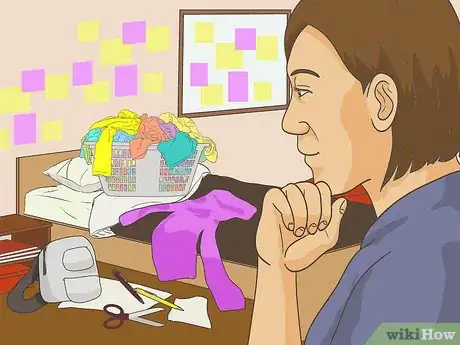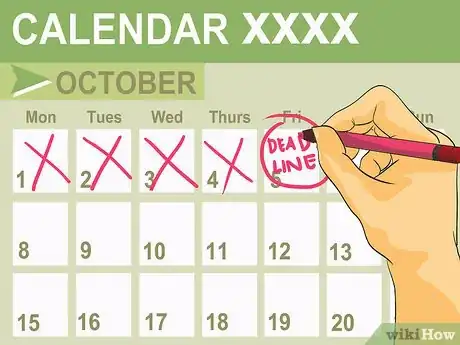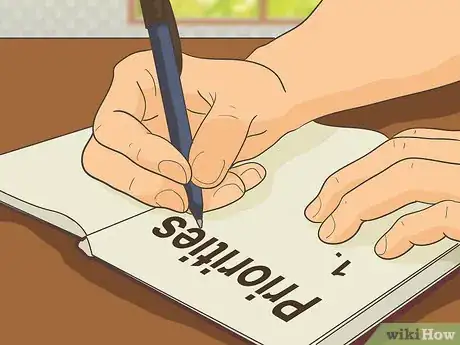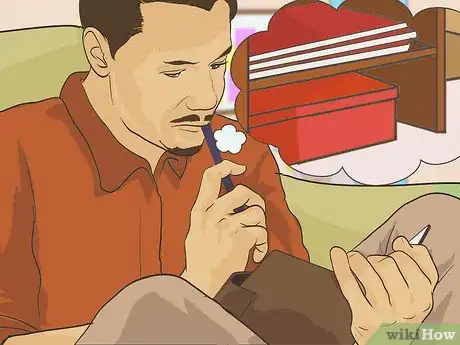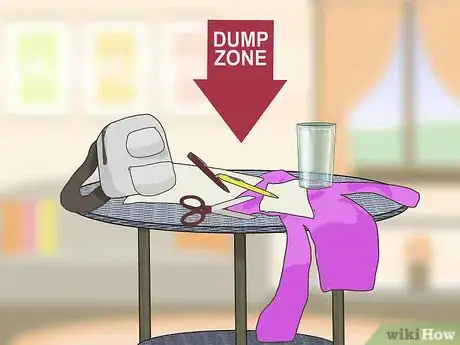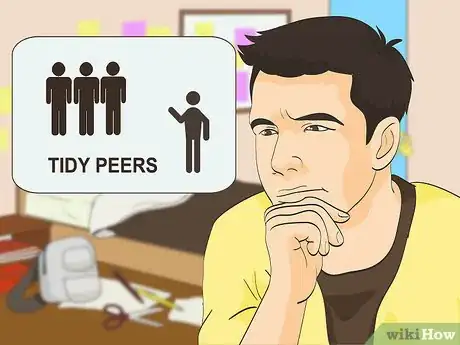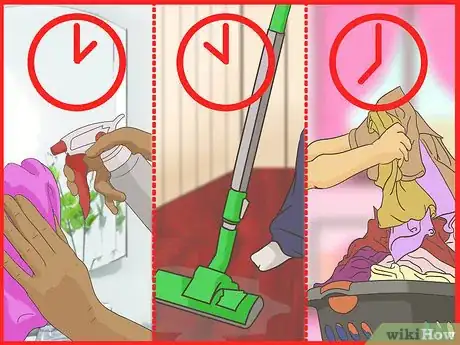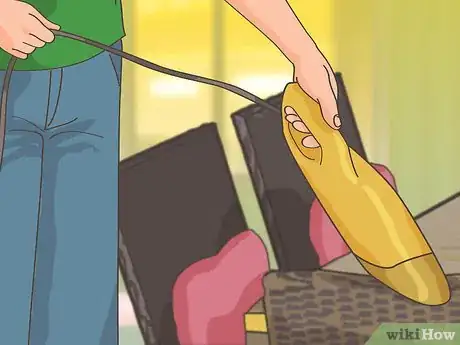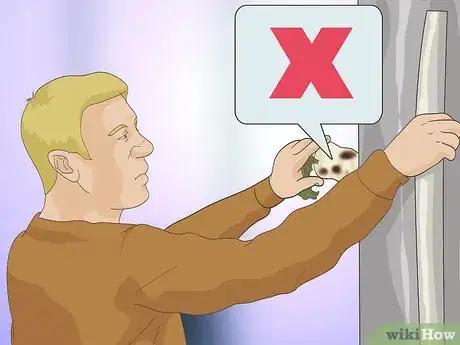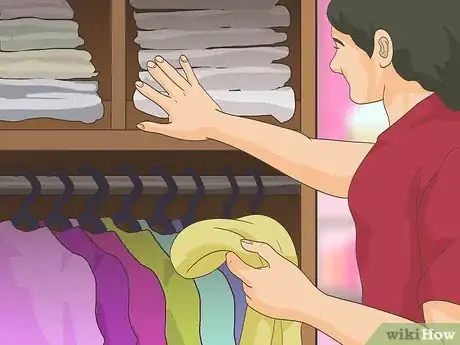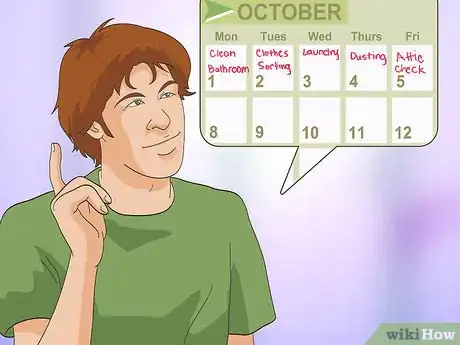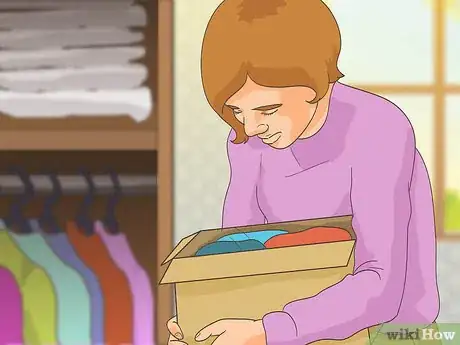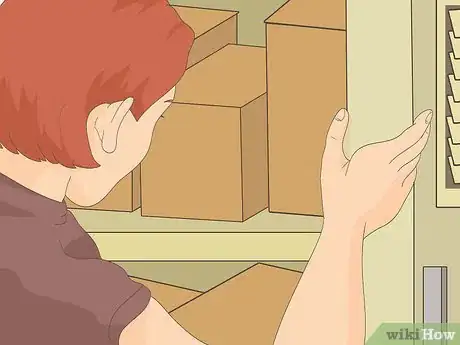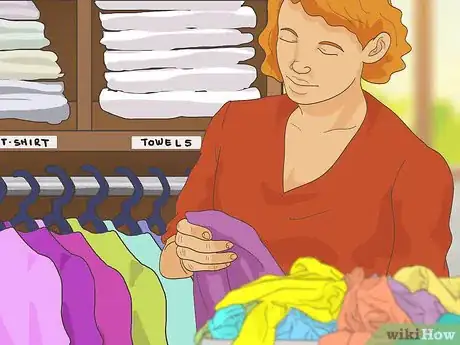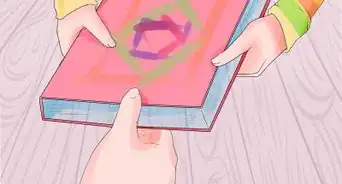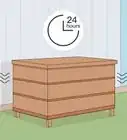This article was co-authored by Ashley Moon, MA. Ashley Moon is the Founder and CEO of Creatively Neat, a virtual organizing and life coaching business based in Los Angeles, California. In addition to helping people organize their best life, she has a fabulous team of organizers ready to de-clutter your home or business. Ashley hosts workshops and speaking engagements at various venues and festivals. She has trained with Coach Approach and Heart Core for organizing and business coaching respectively. She has an MA in Human Development and Social Change from Pacific Oaks College.
There are 11 references cited in this article, which can be found at the bottom of the page.
This article has been viewed 32,302 times.
Having a messy environment can cause you to lose track of your belongings, is often unsanitary, and can even interfere with your ability to relax and concentrate. Individuals who want to transition from being messy to neat can effectively do so through a series of gradual lifestyle changes. Tidy your messy mindset to build more organized thought patterns, and overcome any mental and social barriers holding you back from a neater lifestyle. You can then exchange your messy habits for neat ones and start tackling any existing messes filling your life with clutter.
Steps
Tidying a Messy Mindset
-
1Determine if being messy has a negative impact on your life. There's nothing inherently wrong with being a messy person; in fact, some studies suggest that spending time in a messy environment can stimulate the brain and enhance creativity.[1] On the other hand, being messy is toxic and unhealthy if it's disrupting your life, causing stress, and interfering with your health and overall well-being.
- Consider the impact your messiness might have on your productivity and overall professional or academic life. Some reports suggest that having a cluttered or messy workspace can decrease motivation and efficiency when performing structured (rather than creative) work. Additionally, when you're at work, your co-workers, supervisors, and clients/customers are more likely to view your work ethic and abilities negatively if they see an unkempt workspace.[2]
-
2Set personal goals that help you stay neat. “Becoming neat” when you're currently a messy person can be an admirable goal, but left at that, it's probably too vague for you to work toward effectively. A good goal should be both specific and positive, and should also involve a clear action plan that will allow you to reach it.[3]
- Define your goal so that it focuses on the positive: instead of saying, "I want to be less messy," which focuses on a negative, say, "I want to be neater and more organized," which focuses on a positive.
- You'll also need to define what terms like "neat" and "organized" mean to you. Ask yourself if you only want a cleaner, clearer environment, or if you also want to better organize your time, goals, and habits.
- After setting a clearer goal, figure out what you'll need to do to achieve it. This may vary by person, but generally, you'll need to set patterns and habits that make becoming and staying neat feel more natural in addition to clearing any existing clutter from your living and work spaces.
Advertisement -
3Write things down. Writing down information you need to remember later is one of the simplest yet most effective ways to organize cluttered thoughts. With all the information thrown at you on a regular basis, attempting to memorize everything will only lead to chaos and forgetfulness.[4]
- You can use your phone, your computer, or a pen and paper. Just make sure you're consistent about the method you choose and also have a way to keep written information organized.
- Write down both "big" and "small" details. Big details include things like notes on school lessons and instructions for projects at work. Small details include things like shopping lists, names of new acquaintances, and birthdays.
-
4Set deadlines but get things done as soon as possible. These two ideas actually pair together naturally. For personal projects that have no deadlines, give yourself deadlines based on how quickly you can reasonably be expected to finish them. Keeping this deadline in mind will make you less prone to procrastinate.[5]
- That said, it might still take some conscious effort to stop procrastinating if you're in the habit of doing so often. Simply focus on getting tasks done as soon as they come up, or as soon as you're able to get to them.
- When you don't set deadlines, it'll be harder to break out of your usual disorganization. When you procrastinate, you're more likely to run into chaotic situations in which multiple things have to get finished in a short amount of time.
-
5Focus on your priorities. While it may seem contrary to the idea of becoming neat, you need to accept that some projects will be imperfect. That's not a result of being messy--that's just the way life is.[6]
- The key here is to organize your priorities well enough to know which things are most important to you. Crucial projects (e.g., a project for school or work) should get more effort and attention. For less crucial tasks, it's okay to postpone the task or complete it in a less-than-perfect way (e.g., simply sorting your movie collection so that it's all in one place without worrying about organizing it by title, genre, etc.).
- By letting yourself remain a little messy when it doesn't matter, you'll save more brain power for neatness when it does matter.
Overcoming Obstacles to Organization
-
1Make cleaning and tidying more enjoyable. Cleaning isn't a chore if you're having fun! Instead of viewing staying neat as a chore or challenge, find ways to make it more fun and enjoyable. For example, wait until you're cleaning up before letting yourself listen to a new CD or audiobook, or time yourself to see how fast you can complete certain chores and reward yourself based on speed.
- It's all about perception. Many people avoid tidying because they can only view it as a chore, which taints the process with a negative hue. If you can turn the process into a game or reward, you'll put a positive spin on something you previously dreaded, making it easier to complete.
-
2Make organization easier for yourself. Sometimes, becoming tidy is difficult for tangible reasons instead of psychological ones. You may not consciously realize it, but if accessing your filing cabinet requires you to dig out a key from a messy desk drawer and move a few boxes crowding the space in front of it, you'll be less likely to go through the effort and more likely to let your papers pile up on the desk.
- Look for any physical obstacles encouraging you to be messy, then brainstorm ways to reduce or remove those obstacles. In the noted example, you could hang the key on a designated key hook and move the filing cabinet out into the open, making it easier to file your papers into their proper places.
-
3Set a designated "dump" zone. Designate one clearly defined space to pile any mess you don't have time to deal with immediately. For instance, you might choose an unused coffee table in a spare bedroom. Limit your messes to this one space, while keeping the rest of your living or work area consistently tidy.[7]
- This way, instead of trying to completely break your messy habits, you're simply controlling them by giving them an outlet you can manage. Doing so can make it easier to be neat outside of that single outlet.
- Additionally, having one "dump zone" makes it easier to know where to find lost items. Just make sure you clean this area occasionally, or else, you'll risk letting it expand beyond its boundaries as more things pile up.
-
4Ask for help when needed. Don't give in to any embarrassment you might feel about your current messy lifestyle. You're trying to improve, and that should be the point you focus on. To that end, don't be afraid to ask for help tidying or organizing when you feel too overwhelmed to manage the task on your own.[8]
- If possible, try to ask someone who's fairly well-organized for help instead of asking someone who is equally messy. This might mean asking your super-tidy brother for help organizing your homework area, or consulting your mentally organized sister for help straightening out your financial papers.
-
5Surround yourself with neat, organized people. Famous philanthropist W. Clement Stone once said “You are a product of your environment. So choose the environment that will best develop you toward your objective.” Spending time with people who are tidy will indirectly influence you to become more organized. Plus, you'll pick up useful tips and tricks about how to stay neat.
- Not all peer pressure is bad. Spending time with tidy peers will encourage you to mimic their behaviors, thus becoming tidier yourself. Plus, if you need some assistance clearing out clutter from your life, you'll already be in contact with some people who have the know-how to help you.
Exchanging Messy Habits for Neat Habits
-
1Develop a cleaning routine or schedule. Making plans to clean your environment regularly and writing these dates on the calendar helps you stay committed to being neat.
- This is an especially crucial step if you're transitioning from being a notably messy person to a neater one. As a messy person, you likely don't have any cleaning rituals or habits currently set in place, so tidying up won't come naturally to you. Being more intentional about your cleaning schedule sets you into a more organized state of mind, and should make it easier to follow through.
-
2Devote at least 15 or 20 minutes per day to tidying. Spending short increments of time on organizing your environment helps you develop the habit of staying neat and clean long-term. For example, spend 15 minutes today organizing the junk drawer in your kitchen, then spend 15 minutes tomorrow organizing all loose papers on desks and tables.[9]
- On a similar note, make your bed immediately after getting up. This makes your room look neater instantly, and helps set the tone for a fresh, new day of staying tidy.
-
3Dust and vacuum at least once per week. Dusting and vacuuming helps the air in your environment stay fresh, and indirectly influences you to stay neat and tidy. Dedicate one day each week for dusting and vacuuming every area you're responsible for, whether that means just your bedroom or your entire apartment.
- Alternatively, you could spread the dusting and vacuuming throughout the week, tackling one area at a time: e.g., take care of your bedroom on Monday, your living room on Tuesday, your home office on Wednesday, etc. This can make the process seem less overwhelming if you have a large space you need to manage.
- Examining dust accumulation on certain items can also help you determine which things need to be put away--a thick layer of dust on an item that you'd need to physically handle to use, like a baseball bat or sewing machine, suggests that the item has been sitting around unused for long periods of time.
-
4Clean out your refrigerator once every three months. Refrigerators packed with clutter and expired food can be hazardous to your health, especially when old foods are stored next to fresh foods. Go through your refrigerator every three months and throw away all expired foods, as well as all nearly expired foods you don't plan on eating before their expiration date.
- While you're at it, go through your pantry and freezer, too. While most pantry and freezer foods last much longer than perishable foods in your refrigerator, they still expire eventually, so you'll also need to clear out these areas. If once every three months seems like too much, try to go through your pantry and freezer at least once every six months.
-
5Go through all your clothing at least once per year. If excess clothing is partly to blame for your messiness, go through your closet and drawers at least once every year to get rid of clothing you no longer wear or need. Clothing that is stained, smells bad, is damaged, no longer fits, or hasn't been worn in over a year should be thrown away or donated to free up closet space.[10]
- Stained or otherwise damaged clothing should be thrown away. Clothing that's in good shape but no longer worn should be donated.
- Many communities have large clothing drop boxes meant for donations located in the parking lots of convenience stores, restaurants, and churches. They often look like brightly colored dumpsters, but will have some instructions or information on them indicating their purpose. These can be a convenient place to drop off any unused clothing you wish to donate if you're too busy to hand it over to a thrift store.
Organizing a Messy Environment
-
1Schedule set times for separate areas. If you need to tidy an existing mess, you might find the task overwhelming, especially depending on how much of a mess you're facing. Work on one room or area at a time to avoid feeling overwhelmed with finding a place for each of your belongings. For example, start with organizing your bathroom one weekend, then organize your living room the next weekend.
- It's a good idea to make a tangible schedule for yourself since doing so will structure your thoughts and better encourage you to stick with your plan. If you already have messy tendencies, relying on a spur-of-the-moment desire to tidy up any certain space will only carry you through that one space; it's unlikely you'll want to extend your efforts beyond that space and into other areas later on, based on the messy habits and mindset you've already built up.
-
2Remove everything for sorting. If you're dealing with a significant mess, it's probably best to start the tidying process by gathering every out-of-place item into one centralized location. Doing so will make it easier to sort through those items and handle each one as needed.
- You should also take this time to dust, vacuum, and disinfect as needed. Clutter often covers up space on your floor, desk, and other surfaces, making it impossible to clean in those areas. Once these previously hidden areas are made bare again, taking a few minutes to clean them can make your living environment healthier and kickstart your desire to keep things looking as clean and clutter-free as possible.
-
3Get rid of things you don't need. Messy people tend to collect useless items with hopes of using them again, such as outdated business cards, old paperback novels, and clothes that no longer fit. As you sort through your pile of clutter, set aside anything you don't use. Recycle and throw away litter and trash, and donate good items you no longer need to thrift stores and charities.[11]
- If there's an item you haven't used in over a year but genuinely expect to use soon, tag it with a sticky note, makeshift flag, or other identifier, and store it alongside the other items you plan on keeping. When you use that item, remove the tag. Go back through your closet or desk in another 6 to 12 months and look for any remaining tags--these will indicate that you truly didn't need the item after all, and it should be safe to get rid of it.
-
4Store items you're not using. If your home or environment isn't designed to accommodate all your belongings the way you desire, pack up and stow away items you're not currently using to reduce clutter. For example, pack away seasonal clothing, books you've read and want to keep, last year's tax paperwork, and various dust-collecting knick-knacks.
- Keep in mind that these should mostly be items you need or will use in the near future. You can keep a few pieces for sentimental reasons, but try not to make a habit of it. Simply transferring all of your clutter to your storage area will only shift the problem out of sight--it won't actually help you become neat.
-
5Have a designated place for everything you're keeping. Organized people usually have a place for everything: pens and pencils go in mugs or pencil boxes, clothes have designated drawers and closet space, and loose papers go in filing cabinets and desks. By setting designated spots for each type of possession, it'll be easier to put things away in their proper place instead of letting them gather in one large, unidentifiable pile.
- Stay away from "miscellaneous" labels.[12] Aside from being a non-descriptive and unhelpful identifier, giving yourself a “miscellaneous” box, file, or junk drawer may encourage you to lazily keep things there instead of putting them away where they actually belong, especially if this miscellaneous box is easier to get to than the proper location. In this way, you could unknowingly reinforce your existing messy habits and undermine your efforts at neatness.
EXPERT TIPAshley Moon is the Founder and CEO of Creatively Neat, a virtual organizing and life coaching business based in Los Angeles, California. In addition to helping people organize their best life, she has a fabulous team of organizers ready to de-clutter your home or business. Ashley hosts workshops and speaking engagements at various venues and festivals. She has trained with Coach Approach and Heart Core for organizing and business coaching respectively. She has an MA in Human Development and Social Change from Pacific Oaks College.Professional Organizer
 Ashley Moon, MA
Ashley Moon, MA
Professional OrganizerOur Expert Agrees: The first step to getting and staying organized is having a home for everything. Then, you need to develop a habit of putting things back in their homes when you're done with them. Slow down and be more mindful of what you're doing and where you're putting things.
Warnings
- Understand the difference between being “messy” and having a hoarding disorder. If you're messy, you've probably just developed a few bad habits you can fix on your own. If you have a hoarding disorder, however, the thought of cleaning your clutter will be emotionally and mentally distressing, and you may need professional help to get better.⧼thumbs_response⧽
References
- ↑ http://www.inc.com/ilan-mochari/creativity-messy-offices.html
- ↑ http://www.forbes.com/sites/jennagoudreau/2012/03/27/the-dangers-of-a-messy-desk/#6fcb0c894636
- ↑ https://www.psychologytoday.com/blog/notes-self/201308/how-set-goals
- ↑ http://www.lifehack.org/articles/productivity/how-organize-your-life-10-habits-really-organized-people.html
- ↑ http://www.lifehack.org/articles/productivity/how-organize-your-life-10-habits-really-organized-people.html
- ↑ http://www.huffingtonpost.com/2013/03/20/organize-your-life-life-organization_n_2908774.html?slideshow=true#gallery/287027/1
- ↑ http://www.huffingtonpost.com/2013/03/20/organize-your-life-life-organization_n_2908774.html?slideshow=true#gallery/287027/5
- ↑ http://www.huffingtonpost.com/2013/03/20/organize-your-life-life-organization_n_2908774.html?slideshow=true#gallery/287027/6
- ↑ https://www.lifehacker.com.au/2014/08/ask-lh-how-can-i-stop-being-so-messy/
